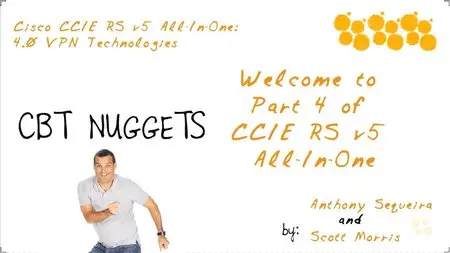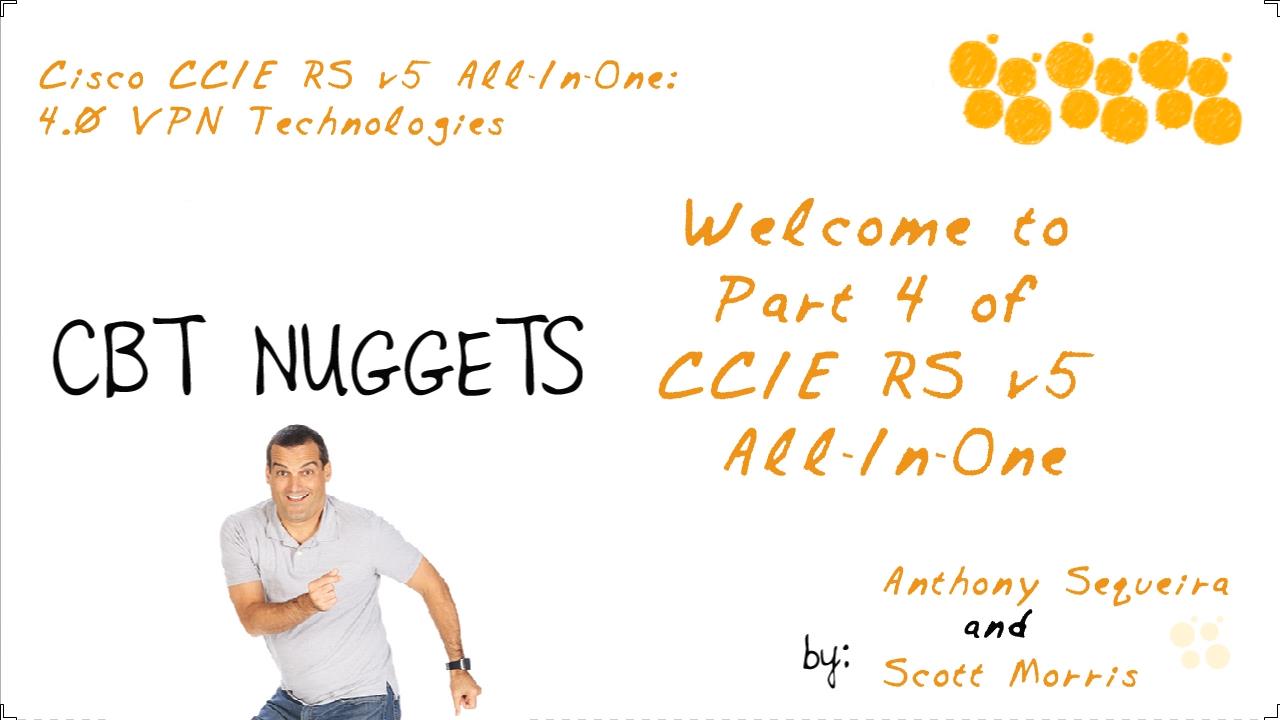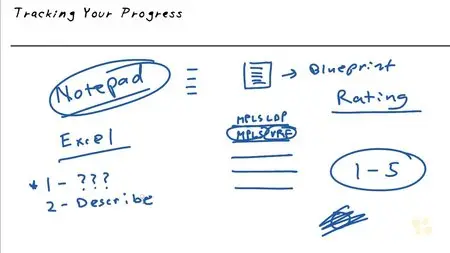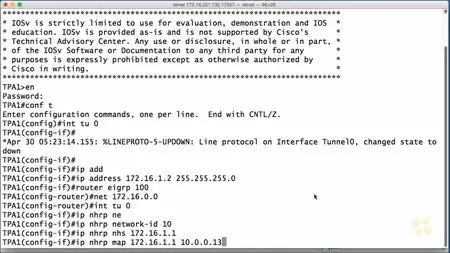Cisco CCIE RS v5 All-In-One: 4.0 VPN Technologies
English | mp4 | H264 1280x720 | AAC 1 ch | 6 hrs 49 min | 1.32 GB
eLearning | Level: Advanced
English | mp4 | H264 1280x720 | AAC 1 ch | 6 hrs 49 min | 1.32 GB
eLearning | Level: Advanced
Part four of our series on the version 5 CCIE R&S training here at CBT Nuggets builds directly on the three previous parts. Here, you prepare for both the written exam as well as the lab exam on key topics involving virtual private networks. From the DMVPN to the GETVPN, master the technologies taking corporations by storm today — as they try and protect their data as it courses through the veins of public Internet connections.
Recommended skills:
Knowledge of CCIE RS v5 All-In-One parts 1 through 3
Recommended equipment:
- GNS3
- VIRL
- IOS 15.x Cisco Routers
Related certifications:
- CCIE RS v5
Related job functions:
- Network admin
- Network operations analyst
- Network technician
- Data Center admin
- Data Center technician
- Cisco Certified Internetwork Expert
Virtual private networking technologies are now quite commonplace in corporate networks. Cisco has responded by adding many topics in this area to the Routing and Switching CCIE. This course ensures you are adequately prepared. And this area is tricky because some of the topic domains are written exam-only, while some are lab potential. To make matters more complicated, many of the topics have a potentially very deep scope, but not so for the Routing and Switching CCIE. This course covers these technologies to the extent you require.
The topic list for this course reads like a “greatest hits” list for recent technologies, including MPLS, DMVPNs, site-to-site VPNS, and GETVPNs. These technologies are not just “nice to have,” but are considered critical in many environments today.
Just as you experienced in the previous three CCIE training courses, this installment provides the theory and the hands-on approach required to master the technologies for written and lab excellence. Topics are broken up into very detailed components to promote easy understanding, as well as pinpoint review areas.
1. Welcome to Part 4 of CCIE RS v5 All-In-One (3 min)
Please enjoy this short introduction video to the remainder of the course.
2. MPLS Labels (8 min)
Where is the label? What is it made up of? Learn all of this and more.
3. LSRs (7 min)
Label switch routers are the stars of the show in your MPLS network. This Nugget breaks down the various types and their roles.
4. LSPs (7 min)
Label-switched paths are used in MPLS to move packets from one location to another in the cloud. This Nugget details this process for you. It also makes clear the concept of a FEC.
5. Bonus Tip: The Cisco Feature Navigator (5 min)
How do you know if your Cisco device can run MPLS so you can follow along with these videos? It is the CFN to the rescue!
6. Label Distribution (7 min)
What are the options for distributing labels throughout the MPLS cloud? This Nugget contains the answers. It also provides a quick review of the label process.
7. The LFIB (6 min)
The label forwarding instance base is a key element of MPLS operations. This Nugget details this and more for you.
8. Creating the Provider Core Topology (15 min)
In this Nugget, Anthony demonstrates how simple it is to use Cisco VIRL in order to create the provider core topology. With a few clicks of the mouse, OSPF is configured between five devices, consisting of two PE devices and three P devices.
9. Configuring Basic MPLS (8 min)
In this Nugget, Anthony demonstrates how remarkably easy it is to configure basic MPLS on IOS devices.
10. Verifying Basic MPLS (12 min)
In this action-packed Nugget, join Anthony as he walks you through verifying the basic MPLS configuration, and the labels used in a sample LSP.
11. LDP at the CLI (20 min)
In this Nugget, we dig deeper into the operation of LDP in MPLS. This Nugget includes key verifications.
12. Bonus Tip: Tracking Your Study Progress (7 min)
This Nugget details a powerful strategy for tracking your progress through the written and lab exams.
13. Troubleshooting the Provider Network (21 min)
This Nugget takes a break from new material and examines a structured approach to troubleshooting the MPLS Provider network.
14. MPLS PING (12 min)
Learn why classic ping will not cut it for your MPLS network. Also, see the new MPLS pin in action.
15. MPLS Traceroute (9 min)
That's right. PING is not the only utility to get a facelift for use with MPLS. This Nugget examines MPLS Traceroute in detail.
16. MBGP on the PE Devices (13 min)
This Nugget guides you through the why and the how of using multi-protocol BGP on the provider edge devices in your Layer 3 MPLS VPN.
17. VRFs on the PE Devices (12 min)
This Nugget dissects the virtual routing and forwarding instances and their creation on the provider edge devices.
18. CE to PE Routing (12 min)
The configuration of the various dynamic routing protocols is slightly unique on the PE devices. This is because of the VRFs. This Nugget reviews these configurations and verifications.
19. Redistr and Verif in the L3 MPLS VPN (20 min)
In this Nugget, we put some finishing touches on the L3 MPLS VPN and verify its functionality.
20. Extranet: Route Leaking (20 min)
What if the MPLS service provider needs to access resources inside a customer site? Or, what if one customer needs to share resources with another customer? This Nugget covers route leaking in the L3 MPLS design.
21. GRE (12 min)
Generic routing encapsulation can be very useful. This Nugget describes how, and walks you through a fully functional demonstration.
22. mGRE (8 min)
This Nugget details multipoint GRE and describes how it can assist us dramatically in the creation of dynamic VPNs.
23. NHRP (7 min)
DMVPNs require that routers run Next Hop Resolution Protocol (NHRP), which uses a client-server model. This Nugget ensures you are up to speed on the theory behind this protocol.
24. Introduction to DMVPN (7 min)
In this Nugget, Anthony introduces you to the DMVPN concept.
25. Building a Practice DMVPN Topology (15 min)
In this Nugget, we prepare to test DMVPN at the command line.
26. NHRP in the DMVPN - EIGRP (22 min)
In this Nugget, we practice the NHRP configuration for the DMVPN at the command line. EIGRP is the dynamic routing protocol used in the private networks.
27. IPSec in the DMVPN (9 min)
This Nugget demonstrates how easy it is to add security to the DMVPN.
28. OSPF in the DMVPN (5 min)
This Nugget ensures you can configure OSPF as the private routing protocol in your DMVPN environment.
29. QoS Pre-Classify (11 min)
What about honoring QoS required information in a packet of the DMVPN? This Nugget reviews some key methods.
30. Legacy Site to Site IPsec VPNs (16 min)
How was the site to site VPN traditionally built with IPsec? This Nugget will show you how.
31. VTI Site to Site IPsec VPNs (14 min)
This Nugget provides a more modern look at IPsec VPNs.These use virtual tunnel interfaces that provide many advantages we will cover.
32. AToM (9 min)
Any Transport over MPLS is really cool. In this Nugget, you find out just how cool it is for connecting your sites at Layer 2.
33. L2TPV3 (10 min)
If you want AToM like behavior, but you lack MPLS, L2TPv3 might just be for you.
34. VPLS (9 min)
Virtual private LAN Service (VPLS) is super cool. This tech allows a provider to connect Ethernet-based sites with a minimum of workload. Learn about this technology here!
35. GET VPN (12 min)
Want a tunnel-less IPsec solution? This Nugget covers one in the GET VPN set of technologies.
Screenshots:











